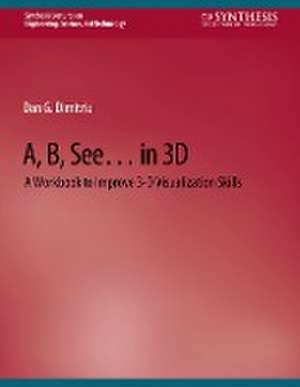A, B, See... in 3D: A Workbook to Improve 3-D Visualization Skills: Synthesis Lectures on Engineering, Science, and Technology
Autor Dan G. Dimitriuen Limba Engleză Paperback – 20 aug 2015
Din seria Synthesis Lectures on Engineering, Science, and Technology
-
 Preț: 393.52 lei
Preț: 393.52 lei -
 Preț: 395.92 lei
Preț: 395.92 lei -
 Preț: 321.34 lei
Preț: 321.34 lei -
 Preț: 284.04 lei
Preț: 284.04 lei - 15%
 Preț: 500.59 lei
Preț: 500.59 lei -
 Preț: 397.38 lei
Preț: 397.38 lei - 15%
 Preț: 581.14 lei
Preț: 581.14 lei -
 Preț: 387.75 lei
Preț: 387.75 lei -
 Preț: 320.40 lei
Preț: 320.40 lei - 20%
 Preț: 594.83 lei
Preț: 594.83 lei -
 Preț: 420.02 lei
Preț: 420.02 lei - 20%
 Preț: 588.21 lei
Preț: 588.21 lei - 18%
 Preț: 738.28 lei
Preț: 738.28 lei - 15%
 Preț: 644.95 lei
Preț: 644.95 lei -
 Preț: 329.98 lei
Preț: 329.98 lei -
 Preț: 214.57 lei
Preț: 214.57 lei -
 Preț: 236.41 lei
Preț: 236.41 lei - 20%
 Preț: 331.25 lei
Preț: 331.25 lei -
 Preț: 320.40 lei
Preț: 320.40 lei - 15%
 Preț: 527.97 lei
Preț: 527.97 lei -
 Preț: 420.97 lei
Preț: 420.97 lei - 15%
 Preț: 583.61 lei
Preț: 583.61 lei -
 Preț: 352.63 lei
Preț: 352.63 lei - 15%
 Preț: 527.97 lei
Preț: 527.97 lei -
 Preț: 396.43 lei
Preț: 396.43 lei - 15%
 Preț: 526.35 lei
Preț: 526.35 lei -
 Preț: 270.36 lei
Preț: 270.36 lei - 18%
 Preț: 735.07 lei
Preț: 735.07 lei - 17%
 Preț: 458.17 lei
Preț: 458.17 lei -
 Preț: 386.81 lei
Preț: 386.81 lei -
 Preț: 389.70 lei
Preț: 389.70 lei - 20%
 Preț: 295.74 lei
Preț: 295.74 lei -
 Preț: 358.76 lei
Preț: 358.76 lei - 15%
 Preț: 523.91 lei
Preț: 523.91 lei -
 Preț: 514.29 lei
Preț: 514.29 lei -
 Preț: 413.76 lei
Preț: 413.76 lei -
 Preț: 404.13 lei
Preț: 404.13 lei -
 Preț: 427.71 lei
Preț: 427.71 lei -
 Preț: 390.63 lei
Preț: 390.63 lei -
 Preț: 221.18 lei
Preț: 221.18 lei - 15%
 Preț: 640.06 lei
Preț: 640.06 lei -
 Preț: 399.81 lei
Preț: 399.81 lei - 15%
 Preț: 531.26 lei
Preț: 531.26 lei - 15%
 Preț: 528.80 lei
Preț: 528.80 lei - 15%
 Preț: 529.60 lei
Preț: 529.60 lei -
 Preț: 386.81 lei
Preț: 386.81 lei
Preț: 142.85 lei
Nou
Puncte Express: 214
Preț estimativ în valută:
27.34€ • 28.44$ • 22.57£
27.34€ • 28.44$ • 22.57£
Carte tipărită la comandă
Livrare economică 10-16 aprilie
Preluare comenzi: 021 569.72.76
Specificații
ISBN-13: 9783031793684
ISBN-10: 3031793684
Ilustrații: II, 144 p.
Dimensiuni: 216 x 279 mm
Editura: Springer International Publishing
Colecția Springer
Seriile Synthesis Lectures on Engineering, Science, and Technology, Synthesis Lectures on Engineering
Locul publicării:Cham, Switzerland
ISBN-10: 3031793684
Ilustrații: II, 144 p.
Dimensiuni: 216 x 279 mm
Editura: Springer International Publishing
Colecția Springer
Seriile Synthesis Lectures on Engineering, Science, and Technology, Synthesis Lectures on Engineering
Locul publicării:Cham, Switzerland
Cuprins
Book Presentation.- List of Problems by Difficulty.- Alphabetical Listing by Letter Combinations.- Chapter 1 - Combination of Cubes.- Chapter 2 - First Level.- Chapter 3 - Second Level.- Chapter 4 - Third Level.- List of Problem Solutions by Chapter.- Author Info.
Notă biografică
Dan D. Dimitriu, PhD, P.E., is a tenured professor in SAC's Physics, Engineering, and Architecture Department and has been the Engineering Program Coordinator at San Antonio College since 2001. He has 21 years of teaching experience in post-secondary education, five years in academic research, and 23 years in private practice as a professional engineer. He has worked on research projects at North Dakota State University and holds also an MBA in International Economic Relations. He has managed several NSF and Department of Education MSEIP grants for SAC, and has been a co-PI for a NASA CIPAIR grant with the University of Texas at San Antonio and for an NSF CCLI grant with Wright University. He was elected Vice Chair of the Two Year College Division of ASEE in 2005 and was the recipient of 2006 NISOD Excellence in Teaching Award. He was also named "San Antonio’s Top Professor" by Scene in SA Monthly in 2006. In 2005 he was the only community college committee member and presenter for the "Enhancing Community College Pathways into Engineering Careers," a collaborative effort by the National Academy of Engineering's Committee on Engineering Education and the National Research Council Board on Higher Education and Workforce. Their final report described the evolving roles of community colleges in engineering education, identified exemplary programs at community colleges and model partnerships between two- and four-year engineering schools, and made recommendations for future research in this area. He has also made numerous presentations at the American Society for Engineering Educators Annual Conferences. Dr. Dimitriu is also coordinator for the Alamo Community College District's participation in NASA's Aerospace Scholars program and concurrently serves as the director for SAC's MESA Center. This workbook is a resultant of his leadership and expertise in developing curricula, coordinating engineering educational programs, years of teaching, and years ofprofessional practice.
